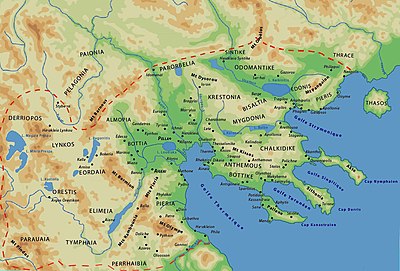Eordaia
Eordaia ( Greek Ἐορδαία ), also called Eordias ( Ἐορδίας ), in ancient times referred to the mountainous landscape of Greece that encompassed the mountain range of Mount Vermio . It is bordered in the north by Lake Vegoritida and in the southeast by the lower reaches of the Aliakmonas River . To the east it falls into the lowland plain of Imathia . The landscape roughly encompassed the east of today's Kozani regional district in the West Macedonia region .
In antiquity, Eordaia bordered the Orestis mountains to the west , Lynkestis to the north across Lake Vegoritida , Elimiotis to the south, and the Pieria mountains to the southeast across the Aliakmonas . In the east, descending the Vermio (old name Bermion), it bordered the Lower Macedonian landscape of Bottiaia .
Eordaia was the easternmost of the so-called Upper Macedonian mountain landscapes , which, according to Thucydides, was originally inhabited by the Eordois people, who had to submit to the Macedonians expanding from Elimiotis and Lynkestis and were absorbed into them. Otto Abel assigned them to the Phrygians , as they would have lived in the "Garden of Midas " mentioned by Herodotus due to their geographical location in the Vermio Mountains (Bermion) . The "Eorder" also mentioned by him, which dates back to 480 BC. According to Fritz Geyer, who joined the army of Xerxes I must already have been Macedonians. In contrast to the other Upper Macedonian countries, no princely house has survived for Eordaia, apparently because this country, due to its border location with Lower Macedonia, was under the direct control of the Argead royal family very early on . They had their first royal seats Beroia (Veria) and Aigai (Vergina) strategically located directly at the transition from Eordaia to the Bottiaia lowlands, over which they established their kingship.
Personalities
As Arrian reports, Ptolemy I came from Eordaia, who after the death of Alexander the Great founded the Hellenistic Ptolemaic dynasty in Egypt , which with the death of Cleopatra VII in 30 BC. BC ended. The late antique author Stephanos of Byzantium , however, claimed that Ptolemy came from the city of "Orestia", which is generally identified with Argos Oresticon in Orestis. However, a rediscovered epigram by Poseidippos confirms Arrian's statements, according to which Ptolemy II boasted that his father was descended from Eordaia.
In 1927, the original Turkish city foundation Kailaria was based on Ptolemy I in Ptolemaida renamed in the church in 2010 Eordaia was incorporated.
Other people:
- Lagos , father of Ptolemy I.
- Menelaus , brother of Ptolemy I.
- Peithon , a bodyguard of Alexander
- Aristonous , a bodyguard of Alexander
literature
- Otto Abel : Macedonia before King Philip (1847).
- Fritz Geyer: Macedonia up to Philip II's accession to the throne. In: Historische Zeitschrift , Vol. 30 (1930), pp. 1–148.
- AB Bosworth: Philip II and Upper Macedonia , In: The Classical Quarterly , Vol. 21 (1971), pp. 93-105.
